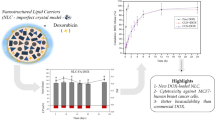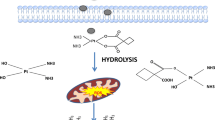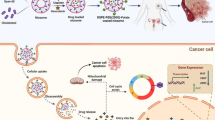Abstract
A folic acid-conjugated paclitaxel (PTX)-doxorubicin (DOX)-loaded nanostructured lipid carrier(s) (FA-PTX-DOX NLCs) were prepared by using emulsion-evaporation method and extensively characterized for particle size, polydispersity index, zeta potential, and % entrapment efficiency which were found to be 196 ± 2.5 nm, 0.214 ± 0.04, +23.4 ± 0.3 mV and 88.3 ± 0.2% (PTX), and 89.6 ± 0.5% (DOX) respectively. In vitro drug release study of optimized formulation was carried out using dialysis tube method. FA-conjugated PTX-DOX-loaded NLCs showed 75.6 and 78.4% (cumulative drug release) of PTX and DOX respectively in 72 h in PBS (pH 7.4)/methanol (7:3), while in the case of FA-conjugated PTX-DOX-loaded NLCs, cumulative drug release recorded was 80.4 and 82.8% of PTX and DOX respectively in 72 h in PBS (pH 4.0)/methanol (7:3). Further, the formulation(s) were evaluated for ex vivo cytotoxicity study. The cytotoxicity assay in doxorubicin-resistant human breast cancer MCF-7/ADR cell lines revealed lowest GI50 value of FA-D-P NLCs which was 1.04 ± 0.012 μg/ml, followed by D-P NLCs and D-P solution with GI50 values of 3.12 ± 0.023 and 3.89 ± 0.007 μg/ml, respectively. Findings indicated that the folic acid-conjugated PTX and DOX co-loaded NLCs exhibited lower GI50 values as compared to unconjugated PTX and DOX co-loaded NLCs; thus, they have relatively potential anticancer efficacy against resistant tumor.








Similar content being viewed by others
Abbreviations
- P:
-
paclitaxel
- D:
-
doxorubicin
- FA:
-
folic acid
- FA-D-P NLCs:
-
folic acid-doxorubicin-paclitaxel nanostructured lipid carrier(s) formulation
- D-P NLCs:
-
doxorubicin-paclitaxel nanostructured lipid carrier(s) formulation
- B-NLCs:
-
plain nanostructured lipid carrier(s) formulation
- D-P- Sol:
-
doxorubicin-paclitaxel solution
- D-sol:
-
doxorubicin-solution
- P-sol:
-
paclitaxel solution
- ADR:
-
adriamycin
References
Torre LA, Bray F, Siegel RL, Jacques F, Tieulent JL, Jemal A. Global cancer statistics. CA Cancer J Clin. 2012;65:87–108.
Tseng CL, Su WY, Yen KC, Yang KC, Lin FH. The use of biotinylated-EGF modified gelatin nanoparticle carrier to enhance cisplatin accumulation in cancerous lungs via inhalation. Biomaterials. 2009;30:3476–85.
Burris HA. Shortcomings of current therapies for non-small-cell lung cancer: unmet medical needs. Oncogene. 2009;28:S4–13.
Wauthoz N, Deleuze P, Hecq J, Roland I, Saussez S, Adanja I, et al. In vivo assessment of temozolomide local delivery for lung cancer inhalation therapy. Eur J Pharm Sci. 2010;39:402–11.
Gottesman MM. Mechanisms of cancer drug resistance. Annu Rev Med. 2002;53(4):615–27.
Guo X, Zhao Z, Chen D, Qiao M, Wan F, Cun D, et al. Co-delivery of resveratrol and docetaxel via polymeric micelles to improve the treatment of drug-resistant tumors. AJPS 2018;1–19.
Gonzalez CD, Clarke PA, Al-Lazikani B, Workman P. Personalized cancer medicine: molecular diagnostics, predictive biomarkers, and drug resistance. Clin Pharmacol Ther. 2013;93(3):252–9.
Kummar S, Chen HX, Wright J, Holbeck S, Millin MD, Tomaszewski J, et al. Utilizing targeted cancer therapeutic agents in combination: novel approaches and urgent requirements. Nat Rev Drug Discov. 2010;9(11):843–56.
Woodcock J, Griffin JP, Behrman RE. Development of novel combination therapies. N Engl J Med. 2011;364(11):985–7.
Wu L, Leng D, Cun D, Foged C, Yang M. Advances in combination therapy of lung cancer: rationales, delivery technologies and dosage regimens. J Control Release. 2017;260:78–91.
Lavan DA, McGuire T, Langer R. Small-scale systems for in vivo drug delivery. Nat Biotechnol. 2003;21(10):1184–91.
Zhang L, Gu FX, Chan JM, Wang AZ, Langer RS, Farokhzad OC. Nanoparticles in medicine: therapeutic applications and developments. Clin Pharmacol Ther. 2008;83(5):761–9.
Agrawal U, Gupta M, Vyas S P. Capsaicin delivery into the skin with lipidic nanoparticles for the treatment of psoriasis. Artif Cells Nanomed Biotechnol. 2013;1–2.
Sharma R, Mody N, Agrawal U, Vyas SP. Theranostic nanomedicine; a next generation platform for cancer diagnosis and therapy. Mini-Rev Med Chem. 2017;17:1–2.
Gregoriadis G, Alexander T. Liposomes in drug delivery clinical, diagnostic and ophthalmic potential. Drugs. 1993;45(I):15–28.
Raniolo S, Vindigni G, Ottaviani A, Unida V, Iacovelli F, Manetto A, et al. Selective targeting and degradation of doxorubicin-loaded folate functionalized DNA nanocages. Nano 2018:2–3.
Tao L, Jiang J, Gao Y, Wu C, Liu Y. biodegradable alginate-chitosan hollow nanospheres for codelivery of doxorubicin and paclitaxel for the effect of human lung cancer A549 cells. Biomed Res Int 2018;1–3.
Chen J, Wu Q, Luo L, et al. Dual tumor-targeted poly(lactic-co-glycolic acid)–polyethylene glycol–folic acid nanoparticles: a novel biodegradable nanocarrier for secure and efficient antitumor drug delivery. Int J Nanomedicine. 2017;12:5745–60.
Muller RH, Mader K, Gohla S. Solid lipid nanoparticles (SLN) for controlled drug delivery- a review of state of the art. Eur J Pharm Biopharm. 2000;50:161–77.
Lee RJ, Low PS. Folate-mediated tumor cell targeting of liposome-entrapped doxorubicin in vitro. Biochim Biophys Acta. 1995;1233:134–6.
Di H, Wu H, Gao Y, Li W, Zou D, Dong C. Doxorubicin and cisplatin loaded nanostructured lipid carriers for breast cancer combination chemotherapy. Drug Dev Ind Pharm. 2016;42:2038–43.
Hu FQ, Yuan H, Zhang HH, Fang M. Preparation of solid lipid nanoparticles with clobetasol propionate by a novel solvent diffusion method in aqueous system and physicochemical characterization. Int J Pharm. 2002;239:121–8.
Wang Y, Zhang H, Hao J, Li B, Li M, Wang X. Lung cancer combination therapy: co-delivery of paclitaxel and doxorubicin by nanostructured lipid carriers for synergistic effect. Drug Deliv 2015;1398–1403.
Lin T, Fang Q, Peng D, Huang X, Zhu T, Luo Q, et al. PEGylated non-ionic surfactant vesicles as drug delivery systems for Gambogenic acid. Drug Deliv. 2013;20:277–84.
Lv S, Tang Z, Li M, Lin J, Song W, Liu H, et al. Co-delivery of doxorubicin and paclitaxel by PEG-polypeptide nanovehicle for the treatment of nonsmall cell lung cancer. Biomaterials. 2014;35:6118–29.
Qiu Y, Wu C, Jiang J, Hao Y, Zhao Y, Xu J, et al. Lipid-coated hollow mesoporous silica nanospheres for co-delivery of doxorubicin and paclitaxel: preparation, sustained release. Mater Sci Eng C 2016;
Feng L, E LL, Soloveiv MM, Wang DS, Zhang BO, Dong YW, et al. Synergistic cytotoxicity of cisplatin and Taxol in overcoming Taxol resistance through the inhibition of LDHA in oral squamous cell carcinoma. Oncol Lett. 2015;9:1827–32.
Pavia LD, Lampman GM, Kriz GS. Introduction to spectroscopy. 3rd ed. Thomson books/Cole; 2001. 41–68.
Varshosaz J, Hassanzadeh F, Mardani A, Rostami M. Feasibility of haloperidol-anchored albumin nanoparticles loaded with doxorubicin as dry powder inhaler for pulmonary delivery. Pharm Dev Technol. 2015;20:183–96.
Huang RF, Wei YJ, Inbaraj BS, Chen BH. Inhibition of colon cancer cell growth by nanoemulsion carrying gold nanoparticles and lycopene. Int J Nanomedicine. 2015;10:2823–46.
Segura S, Espuelas S, Renedo MJ, Irache JM. Potential of albumin nanoparticles as carriers for interferon gamma. Drug Dev Ind Pharm. 2005;31:271–80.
Zheng C, Liu X, Zhu J, Zhao Y. Preparation of cationic biodegradable dextran microspheres loaded with BSA and study on the mechanism of protein loading. Drug Dev Ind Pharm. 2012;38:653–8.
Hwang TL, Aljuffali IA, Lin CF, Chang YT, Fang JY. Cationic additives in nanosystems activate cytotoxicity and inflammatory response of human neutrophils: lipid nanoparticles versus polymeric nanoparticles. Int J Nanomedicine. 2015;10:371–85.
Acknowledgments
We also acknowledge the Sophisticated Instruments Centre, Dr. H.S. Gour Central University, Sagar (India), for providing the SEM analysis and TEM analysis. The authors would also like to acknowledge Neon Laboratories, Mumbai (India), for providing the gift sample of paclitaxel and M/s. Sun Pharma Advanced Research Centre (SPARC) Vadodara, Gujarat (India), for providing the gift samples of doxorubicin, as well as Lipoid (Germany) for the generous gift sample of DSPE. We sincerely acknowledge Dr. Jyoti Kode, Tata Memorial Center-ACTREC, Kharghar, Navi Mumbai (India) for her support in carrying out the ex vivo studies.
Funding
Financial support was provided by the All India Council of Technical Education (AICTE), New Delhi (India) (Sarjana Raikwar).
Author information
Authors and Affiliations
Corresponding author
Ethics declarations
Conflicts of Interest
The authors declare that they have no conflict of interest.
Rights and permissions
About this article
Cite this article
Raikwar, S., Vyas, S., Sharma, R. et al. Nanocarrier-Based Combination Chemotherapy for Resistant Tumor: Development, Characterization, and Ex Vivo Cytotoxicity Assessment. AAPS PharmSciTech 19, 3839–3849 (2018). https://doi.org/10.1208/s12249-018-1185-y
Received:
Accepted:
Published:
Issue Date:
DOI: https://doi.org/10.1208/s12249-018-1185-y




